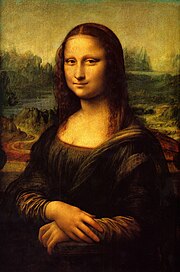Painting
From Wikipedia, the free encyclopedia.
Painting is the practice of applying pigment suspended in a carrier (or medium) and a binding agent (a glue) to a surface (support) such as paper, canvas or a wall. This is done by a painter; this term is used especially if this is his or her profession. Evidence indicates that humans have been painting for about 6 times as long as they have been using written language. Artistic painting is considered by many to be among the most important of the art forms.
Drawing, by comparison, is the process of making marks on a surface by applying pressure from or moving a tool on the surface.
Contents |
History of painting
- Main article: History of Painting
The oldest known paintings are at the Grotte Chauvet in France, dated at about 32,000 years old. They are engraved and painted using red ochre and black pigment and show horses, rhinoceros, lions, buffalo, and mammoth. There are examples of cave painting all over the world.
See also Art history.
Painting techniques
Painting techniques include:
- Impasto
- Computer painting (Digital)
- Glaze
- Grisaille
- New materials (painting)
- Pointillism (aka divisionism, 'stippling')
- Scumble
- Sfumato
- Sumi-e
- Wash
- Brush Painting
- (Partially) destructive techniques like grattage and peinture brulée, with which Joan Miró, among others, experimented.
Painting supports
- Canvas
- Panel painting
- Mural (Walls)
- Paper
Painting media
Different types of paint are usually identified by the medium that the pigment is suspended or embedded in, which determines the general working characteristics of the paint, such as viscosity, miscibility, solubility, drying time, etc.
Examples include:
- Acrylic
- Encaustic (wax)
- Fresco
- Gouache
- Ink
- Oil
- Heat-set oils
- Water miscible oil paints
- Pastel, including dry pastels, oil pastels, and pastel pencils
- Spray paint (Graffiti)
- Tempera
- Watercolor
Popular painting styles
'Style' is used in two senses: It can refer to the distinctive visual elements, techniques and methods that typify an individual artist's work. It can also refer to the movement or school that an artist is associated with. This can stem from an actual group that the artist was consciously involved with or it can be a category in which art historians have placed the painter. The word 'style' in the latter sense has fallen out of favour in academic discussions about contemporary painting, though it continues to be used in popular contexts.
- Abstract
- Baroque
- Constructivism
- Cubism
- Fauvism
- Graffiti
- Hard-edge
- Impressionism
- Mannerism
- Modernism
- Naïve art
- Neo-classicism
- Op-Art
- Orientalism
- Pointillism
- Pop-Art
- Postmodernism
- Realism
- Romanticism
- Socialist Realism
- Surrealism
Common painting idioms
Painting idioms include:
- Allegory
- Bodegon
- Botanical
- Figure painting
- Illustration
- Industrial
- Landscape
- Portrait
- Still life
- War
A proposed and yet-unrealised development in painting is four dimensional painting.
Philosophy of painting
Much theory of art is connected with painting. In 1890, the Parisian painter Maurice Denis famously asserted: "Remember that a painting – before being a warhorse, a naked woman or some story or other – is essentially a flat surface covered with colours assembled in a certain order." Thus many twentieth century developments in painting, such as Cubism, were reflections on the business of painting rather than on the external world, nature, which had previously been its core subject.
A recent contribution to thinking about painting was offered by Julian Bell, in his book What is Painting?. A painter himself, Bell discusses the development, through history, of the notion that paintings can express feelings and ideas. The text is witty and sometimes caustic in order to make his points ("Let us be brutal: expression is a joke. Your painting expresses – for you; but it does not communicate to me. You had something in mind, something you wanted to ‘bring out’; but looking at what you have done, I have no certainty that I know what it was...").
See also
External links
Art-related sites:
- Athenaeum - onlines tools for studying the humanities
- dmoz - painting topics
- Artcyclopedia - guide to art on the internet




